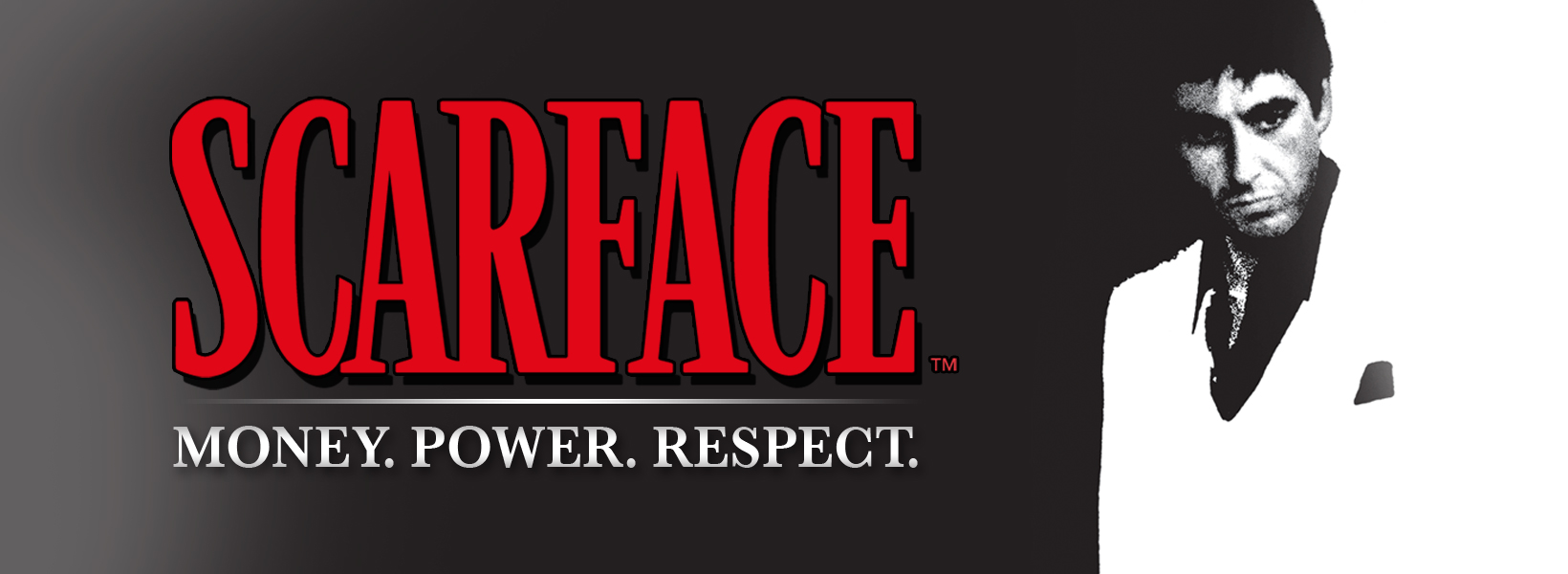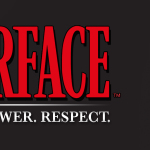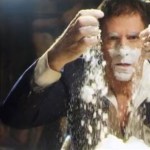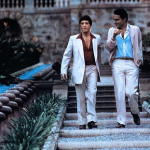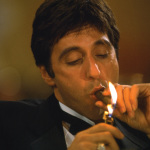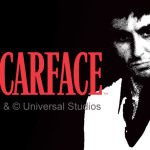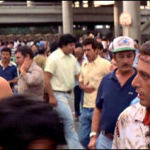Scarface is Pacino‘s “other” gangster pic, but being directed by Brian de Palma, written by Oliver Stone and being set among the criminal Cuban immigrant populations it has a totally different look and feel to The Godfather. It is also a contemporary 1983 remake of a 1932 movie of the same name starring the legendary Paul Muni (star turn in I Am A Fugitive From A Chain Gang), though with notably more excesses – graphic violence, drug use and language that would not have escaped past the censors in the 30s.
Many viewers, perhaps judging by the standards of The Godfather, were apparently put off by this, though the response was that most of the violence is implied, not displayed – though there is no shortage of fake gore on display, whatever anyone thinks, enough ladled on to make you think horror movie. Is it necessary? Think of this as a knowingly stylistic touch, designer gore, not a realistic depiction.
In De Palma’s hands, Scarface is a movie sharply contrasted from its illustrious predecessors. In style it is poles apart from either. Where in the Godfather and the original Scarface the sharpest of pin-sharp suits were order of the day, this Scarface is knowingly dated with its smart white double breasted suits with wide lapels, silk shirts unbuttoned to the waist and wide collars worn outside the jacket. The women mimic the look with swooping necklines and nothing so prosaic as a bra!
The look of the swish venues and latino disco music also repulses any classic feel, which was probably quite deliberate on the part of De Palma. Sorry Brian, but the early 80s was not a hip and trendy period to relay to the big screen, certainly not one that you’d want to capture in a timeless gangster epic at any rate.
But, but… these days Scarface has more than just a cult following, which makes me wonder what people see in it.
Essentially this movie tells of the rise and defiant fall of eponymous Tony “Scarface” Montana, the fall due to making two essential mistakes: pissing off too many people on the way to the top, and snorting his own imported produce, gaining massive paranoia in the process – though not before his own sense of omnipotence makes him an easy target for a police sting operation.
In an unsavoury underworld, Scarface becomes the meanest SOB of the lot, though I wished at times he had been more underplayed. The scenes that work best are where Pacino acts with few words and fewer gestures, not where he is showing who is boss. The scene where he forces his erstwhile boss Frank Lopez (long-time journeyman Robert Loggia) to beg for his life is frankly embarrassing.
A gargantuan ego-filled cocaine-fuelled descent notwithstanding, Montana is not a likeable character, nor yet as iconic or charismatic as Michael Corleone. Quiet authority is somehow far more chilling than ranting and raving, waving guns and suchlike. Where Corleone becomes unassailable in barely more than a whisper, Montana grows increasingly grotesque, a monster, a man sending himself up while killing many with impunity.
In fact, you’d be struggling to identify any sympathetic characters here, though Gina (Mary Elizabeth Mastrantonio), the sister Montana defends and protects to his eventual cost, and the life of his best friend and Gina, is about as close as it gets. Montana’s drug-addled wife Elvira is given a fragile vulnerability by the young Michelle Pfeiffer, but certainly never is she a woman with hidden depths, certainly not a woman you would want to know. There is a fine supporting cast, including the excellent F Murray Abraham – he of Amadeus Oscar fame but distinctly out of his comfort zone as Omar. In fact this movie gave opportunities to a range of Latino actors who typically found decent roles hard to come by in Hollywood at the time.
Perhaps the characterisations and Stone-inspired scripting should offer more light and shade, but there’s no denying that along the way there are iconic moments, some of which have since fallen into movie folklore. Heard the line, “Say hello to my little friend” before? The little friend in question is an M16 rifle equipped with a grenade launcher, but even with friends like that is outnumbered and eventually gunned down in spectacular fashion, over the balcony of his drug lord’s mansion and down into pool below. Even the money counting scenes and vast excesses seem to earn a nod from Scorcese in The Wolf of Wall Street.
If I’m being honest, Scarface is not a movie I’d choose to see again. I have seen Goodfellas a few times and The Godfather a lot more. Maybe I’m not entirely alone in that assessment, since the word on the street was not universal praise. But when you’re Pacino that doesn’t matter – you’ve got it, and when you’ve got it you’ve got it. The legacy is well established and formed a life of its own. From Wikipedia:
While Pacino was already an established successful actor, Scarface helped launch Pfeiffer’s and Mastrantonio’s careers, both of whom were relatively unknown beforehand and who would go on to individual successes. In June 2008, the American Film Institute revealed its “Ten Top Ten”—the best ten films in ten “classic” American film genres—after polling over 1,500 people from the creative community. Scarface was acknowledged as the tenth best in the gangster film genre. The line “Say hello to my little friend!” (spoken by Montana) took 61st place on AFI’s 100 Years… 100 Movie Quotes list, and Tony Montana was nominated as a villain on AFI’s list of the 100 Heroes & Villains. Entertainment Weekly ranked the film #8 on their list of “The Top 50 Cult Films,” and Empire Magazine placed it among the top 500 films of all time, at #284. In 2010, VH1 rated the movie at number 5 in its list of 100 greatest movies of all time. In 2009, Total Film listed at number 9 on their list of the 30 Greatest Gangster movies. Scarface was the first film in which the expletive “fuck” is used 226 times in total. The company set up by former Iraqi dictator Saddam Hussein to launder money was named Montana Management after Pacino’s character.

